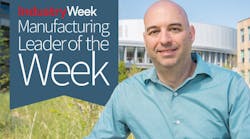Whirlpool Corp. wants to sell appliances and it does so in massive quantities, to the tune of $21 billion annually. But the world’s largest appliance manufacturer also wants to create a relationship with its customers where they can be “proud” of purchasing a Whirlpool product, not only because of how it performs but because of what the company does to “create a healthier and better planet,” says Ron Voglewede, Whirlpool’s director of global sustainability.
Key elements of Whirlpool’s sustainability strategy involve getting a handle on materials usage and energy efficiency. Some of those efforts include:
- Using materials that reduce environmental impact, such as using a liquid blowing agent for refrigeration developed by Honeywell that improves insulation while reducing the potential for global warming by 99.9% compared to current materials.
- Improving the efficiency of manufacturing facilities, through the implementation of LEED-certified buildings and using electric lift trucks
- Producing Energy Star-compliant appliances and working with companies such as Ford and Nest on smart home integration and home resource efficiency.
- Setting a goal of 100% zero waste to landfills by 2022.
But with 70 facilities and 93,000 employees globally, developing and coordinating sustainability efforts across Whirlpool’s is no easy feat. Voglewede observed that employees wanted to do the right thing environmentally but their grassroots efforts were disjointed and often lacked the data to ensure that they were getting the biggest bang for the buck.
Whirlpool has been making great strides on that front since adopting Schneider Electric’s EcoStruxure Resource Advisor, a software platform that allows it to track, measure and analyze energy and waste data across its manufacturing plants.
With the data that the EcoStruxure system was able to generate, Whirlpool discovered it had 20 million pounds of corrugated cardboard waste in its Ohio plants. By recycling this waste, the company will save $1 million over the next three years.
Additionally, three plants in Brazil have achieved Whirlpool’s zero-waste-to-landfill goal two years earlier than expected thanks to these tracking capabilities.
Whirlpool is also using the EcoStruxure Resource Advisor to create a business case to expand its renewable energy program by showing the costs and savings associated with renewables. Wind turbines at one U.S. plant provide 15% of the site’s electricity, and the company is quickly expanding wind power to other sites.
Voglewede said the company went through the usual change management challenges in introducing an unfamiliar system. He said having Schneider provide local resources for the plants was particularly important in managing the transformation because it dealt with language barriers and different time zones.
“They had someone to go to who was local,” he observed, noting that running such a program from a corporate center is “extremely difficult unless you have boots on the ground.”
While Whirlpool has corporate sustainability goals, Voglewede said it was important to make sure that these goals were translated into local goals that individuals understood at the plants. So, for example, if Whirlpool’s goal was to exceed the carbon goals in the Paris Accord, he said:
“What does that mean for me and the energy that I'm using in a plant?” he said, explaining that with the data from the EcoStruxure system, “What we're able to do is translate that all the way out and say, ‘Okay, for you that means by 3% per year productivity.'”
Improved data and communication of Whirlpool’s performance also helps the company’s relationship with its major trade partners such as Ikea, he noted.
“It is helping us to explain and maintain our relationships or even grow our relations with retailers like Ikea for example whose whole brand is centered around sustainability. We can show that we're over 95% recycled material already in all our plants which is massive on the scale of how big we are. This just creates confidence in what we're doing for them.”
While Whirlpool is changing how it tracks and manages material waste, Voglewede said the company was also changing how it views this material.
“We still haven’t got there totally yet but the material is not a waste. It's just a raw material, an alternative raw material and we really have to start using that language,” he said.
Putting the EcoStruxure system in place helped Whirlpool meet its 2015 sustainability goals three years ahead of the original 2020 target. Translating that feat into dollars, he noted, meant “tens of millions in energy savings.” Demonstrating the business value of the system, he says, has moved the issue from “do we want to do it” to “how best do we use this.” The view of the system, he said, changed from viewing it as a “reporting tool to a valuable tool to actually drive efficiency and value.”




